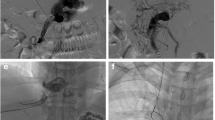Abstract
Proximal splenorenal shunt (PSRS), commonly performed for non-cirrhotic portal hypertension (NCPH), diminishes elevated portal venous pressure (PP) and prevents its sequelae. The change in PP after PSRS and its correlation with clinical outcome is largely unknown. Twenty-four patients who underwent PSRS for NCPH were evaluated prospectively. PP was measured after completion of splenectomy and after PSRS. Follow-up for 3 months was done to assess shunt patency and other relevant clinical variables. Change in PP and shunt patency were correlated with clinical outcome. Seventeen patients had extrahepatic portal vein obstruction (EHPVO) and seven had non-cirrhotic portal fibrosis (NCPF). There was a significant decrease in PP (median10 mmHg) after PSRS (p < 0.001), while decrease following splenectomy alone was not significant (p = 0.06). At 3 months, shunt patency rate was 87.5%. There was improvement in variceal grade at follow-up (p < 0.001). Change in PP did not correlate with splenic vein diameter, shunt diameter, blood flow across the shunt, shunt patency, postoperative complications, change in variceal grade, and need for endotherapy after surgery (p > 0.05). Shunt patency showed significant correlation with splenic vein diameter (p = 0.018), shunt diameter (p = 0.024), blood flow across shunt (p = 0.023), change in variceal grade (p = 0.032), and need for endotherapy (p = 0.002). PP decreases after PSRS in patients with NCPH. However, this does not correlate with clinical outcome. A patent shunt at 3 months correlated with most of these variables.

Similar content being viewed by others
References
Khanna R, Sarin SK (2014) Non-cirrhotic portal hypertension - diagnosis and management. J Hepatol 60(2):421–441
Jha SK, Kumar A, Sharma BC, Sarin SK (2009) Systemic and pulmonary hemodynamics in patients with extrahepatic portal vein obstruction is similar to compensated cirrhotic patients. Hepatol Int 3(2):384–391
Poddar U, Borkar V (2011) Management of extra hepatic portal venous obstruction (EHPVO): current strategies. Trop Gastroenterol 32(2):94–102
Chaudhary N, Mehrotra S, Srivastava M, Nundy S (2013) Management of bleeding in extrahepatic portal venous obstruction. Int J Hepatol 2013:e784842
Khanna R, Sarin SK (2018) Idiopathic portal hypertension and extrahepatic portal venous obstruction. Hepatol Int 12(Suppl 1):148–167
Prasad AS, Gupta S, Kohli V, Pande GK, Sahni P, Nundy S (1994) Proximal splenorenal shunts for extrahepatic portal venous obstruction in children. Ann Surg 219(2):193–196
Sun Y-W, Chen W, Luo M, Hua R, Liu W, Huo Y-M, Wu ZY, Cao H (2010) Evaluation of surgical procedure selection based on intraoperative free portal pressure measurement in patients with portal hypertension. Hepatobiliary Pancreat Dis Int HBPD INT 9(3):269–274
Agarwal AK, Sharma D, Singh S, Agarwal S, Girish SP (2011) Portal biliopathy: a study of 39 surgically treated patients. HPB 13(1):33–39
World Medical Association (2013) World Medical Association Declaration of Helsinki: ethical principles for medical research involving human subjects. JAMA 310(20):2191–2194
Conn HO (1967) Ammonia tolerance in the diagnosis of esophageal varices. A comparison of endoscopic, radiologic, and biochemical techniques. J Lab Clin Med 70(3):442–451
Dindo D, Demartines N, Clavien P-A (2004) Classification of surgical complications: a new proposal with evaluation in a cohort of 6336 patients and results of a survey. Ann Surg 240(2):205–213
Sharma BC, Singh RP, Chawla YK, Narasimhan KL, Rao KL, Mitra SK et al (1997) Effect of shunt surgery on spleen size, portal pressure and oesophageal varices in patients with non-cirrhotic portal hypertension. J Gastroenterol Hepatol 12(8):582–584
Mishra PK, Patil NS, Saluja S, Narang P, Solanki N, Varshney V (2016) High patency of proximal splenorenal shunt: a myth or reality ? - a prospective cohort study. Int J Surg Lond Engl 27:82–87
Bajpai M, Kumar A, Paul S, Jana M, Sharma N (2014) Portal hypertension: a critical appraisal of shunt procedures with emphasis on distal splenorenal shunt in children. J Indian Assoc Pediatr Surg 19(2):80–84
Chocarro G, Junco PT, Dominguez E, Amesty MV, Nuñez Cerezo V, Hernandez F et al (2016) Portal cavernoma in the Era of Mesoportal Shunt (Rex) and liver transplant in children. Eur J Pediatr Surg 26(1):7–12
Pal S, Mangla V, Radhakrishna P, Sahni P, Pande GK, Acharya SK, Chattopadhyay TK, Nundy S (2013) Surgery as primary prophylaxis from variceal bleeding in patients with extrahepatic portal venous obstruction. J Gastroenterol Hepatol 28(6):1010–1014
Acknowledgements
The authors thank Dr. Guresh Kumar and Dr. Archisman Mohapatra for their contribution in the statistical analysis of the study.
Author information
Authors and Affiliations
Corresponding author
Ethics declarations
This prospective observational study was approved by the institutional review board.
Conflict of Interest
The authors declare that they have no conflict of interest.
Rights and permissions
About this article
Cite this article
Mohapatra, N., Sandhyav, R., Agrawal, N. et al. Effect of Proximal Splenorenal Shunt on Intraoperative Portal Venous Pressure and Its Correlation with Clinical Outcomes. Indian J Surg 81, 338–343 (2019). https://doi.org/10.1007/s12262-018-1803-7
Received:
Accepted:
Published:
Issue Date:
DOI: https://doi.org/10.1007/s12262-018-1803-7




